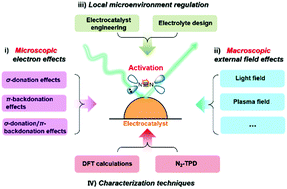Strategies to activate inert nitrogen molecules for efficient ammonia electrosynthesis: current status, challenges, and perspectives
Abstract
The electrocatalytic N2 reduction reaction (NRR) offers an alternative to the traditional Haber–Bosch (H–B) process for the synthesis of ammonia (NH3) and has received a surge of interest recently. However, as the prerequisite step for an efficient NRR, the N2 activation process over an electrocatalyst is rather difficult to be realized under mild conditions due to the thermodynamic stability and chemical inertness of the N2 molecule, which greatly limits the selectivity and activity of the NRR process, as well as the development of this renewable synthesis route for NH3. To date, a variety of electrocatalysts have been developed for effective N2 activation in the past five years, although the presented activation abilities for N2 molecules remain unsatisfactory even on the laboratory scale, and the corresponding design concepts/principles are still at the trial-and-error stage. Instead of focusing on labeling and classifying NRR electrocatalysts that have been extensively reviewed elsewhere, we herein present a timely and comprehensive review of emerging strategies to activate the inert N2 molecule for NH3 electrosynthesis at the microscopic and macroscopic level on the basis of an in-depth understanding of the physicochemical properties and microelectronic structure of the N2 molecule. We initially analyze the physicochemical properties and the microelectronic structure of the N2 molecule from the perspective of molecular orbital theory. On the basis of this, we then emphasize the microscopic electronic effects of electrocatalysts for enhancing N2 activation at length, typically covering σ-donation, π-backdonation, and σ-donation/π-backdonation effects, along with the design concepts/principles of electrocatalysts. Subsequently, the driving forces of macroscopic external fields (such as light, plasma, etc.) and the local microenvironment regulation-induced built-in electrostatic fields for assisting N2 activation are introduced. In addition, the methodologies for studying the N2 activation process over electrocatalyst surfaces are also presented from theoretical and experimental perspectives. Finally, we look at the future research directions and opportunities for improving N2 activation and stimulating the practical application of NRR technology, covering electrocatalyst engineering, process intensification, and device architecture.



 Please wait while we load your content...
Please wait while we load your content...